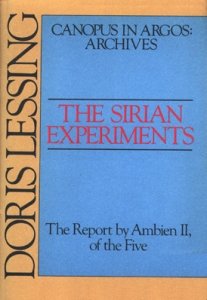Canopus is the brightest star in the southern constellation of Carina.

Doris May Lessing was a British novelist. She was born to British parents in Iran, where she lived until 1925. Her family then moved to Southern Rhodesia, where she remained until moving in 1949 to London, England. Her novels include The Grass Is Singing (1950), the sequence of five novels collectively called Children of Violence (1952–1969), The Golden Notebook (1962), The Good Terrorist (1985), and five novels collectively known as Canopus in Argos: Archives (1979–1983).
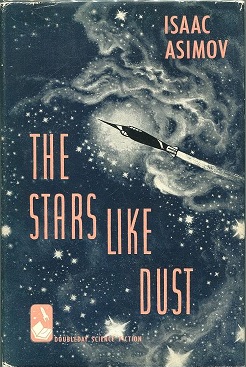
The Stars, Like Dust is a 1951 science fiction mystery book by American writer Isaac Asimov.

Re: Colonised Planet 5, Shikasta is a 1979 science fiction novel by Doris Lessing, and is the first book in her five-book Canopus in Argos series. It was first published in the United States in December 1980 by Alfred A. Knopf, and in the United Kingdom in November 1979 by Jonathan Cape. Shikasta is also the name of the fictional planet featured in the novel.

Wasp is a 1957 science fiction novel by English author Eric Frank Russell. Terry Pratchett stated that he "can't imagine a funnier terrorists' handbook." Wasp is generally considered Russell's best novel.

Lucky Starr and the Big Sun of Mercury is the fourth novel in the Lucky Starr series, six juvenile science fiction novels by Isaac Asimov that originally appeared under the pseudonym Paul French. The novel was first published by Doubleday & Company in March 1956. Since 1972, reprints have included a foreword by Asimov explaining that advancing knowledge of conditions on Mercury has rendered some of the novel's descriptions of that world inaccurate.

Dancing at the Edge of the World is a 1989 nonfiction collection by Ursula K. Le Guin.
Social science fiction is a subgenre of science fiction, usually soft science fiction, concerned less with technology/space opera and more with speculation about society. In other words, it "absorbs and discusses anthropology" and speculates about human behavior and interactions.

Serious Sam 2 is a first-person shooter video game released for Microsoft Windows and Xbox and the sequel to the 2002 video game Serious Sam: The Second Encounter. It was developed by Croteam and was released on 11 October 2005. The game was initially published by 2K Games, a Take-Two Interactive subsidiary. The game was later made available on Steam on 31 January 2012. While the game was originally released only for Microsoft Windows and Xbox, an unofficial Linux version of the game was created and is being handled by Linux Installers for Linux Gamers.
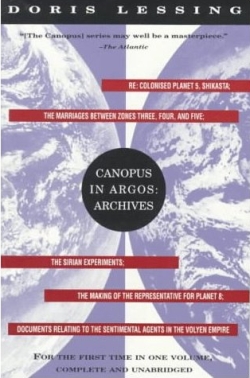
Canopus in Argos: Archives is a sequence of five science fiction novels by Nobel laureate author Doris Lessing, which portray a number of societies at different stages of development, over a great period of time. The focus is on accelerated evolution guided by advanced species for less advanced species and societies.
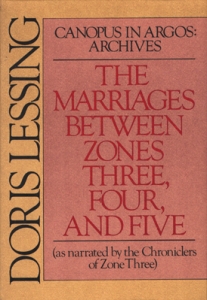
The Marriages Between Zones Three, Four and Five is a 1980 science fiction novel by Doris Lessing. It is the second book in her five-book Canopus in Argos series, the first being Shikasta (1979). It was first published in the United States in March 1980 by Alfred A. Knopf, and in the United Kingdom in May 1980 by Jonathan Cape.

The Making of the Representative for Planet 8 is a 1982 science fiction novel by Doris Lessing. It is the fourth book in her five-book Canopus in Argos series and relates the fate of a planet, under the care of the benevolent galactic empire Canopus, that is plunged into an ice age. It was first published in the United States in January 1982 by Alfred A. Knopf, and in the United Kingdom in March 1982 by Jonathan Cape.

(Documents Relating to) The Sentimental Agents in the Volyen Empire is a 1983 science fiction novel by Doris Lessing. It is the fifth book in her five-book Canopus in Argos series and comprises a set of documents that describe the final days of the Volyen Empire, located at the edge of our galaxy and under the influence of three other galactic empires, the benevolent Canopus, the tyrannical Sirius, and the malicious Shammat of Puttiora. It was first published in the United States in March 1983 by Alfred A. Knopf, and in the United Kingdom in May 1983 by Jonathan Cape.

The Good Terrorist is a 1985 political novel written by the British novelist Doris Lessing. The book's protagonist is the naïve drifter Alice, who squats with a group of radicals in London and is drawn into their terrorist activities.
Sirian or Sirians may refer to:
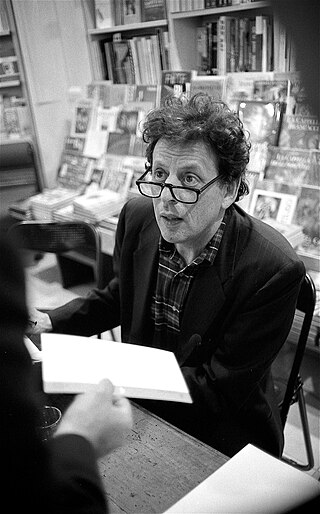
The Making of the Representative for Planet 8 is a full-scale opera by Philip Glass with a libretto by Doris Lessing based on her novel of the same name, first performed in 1988. Together with Glass's 1997 opera The Marriages Between Zones Three, Four and Five, it is part of a planned trilogy of operas based on Lessing's Canopus in Argos novels.
Le Micromégas is a 1752 novella by the French philosopher and satirist Voltaire. Along with his story "Plato's Dream", it is an early example in the literary genre of science fiction and has its place in the development of the history of literature. Some uncertainty surrounds the first publication of Micromégas, with possible editions dating to 1751 or as early as 1739, but with the widely accepted publication being 1752.

Alfred and Emily is a book by Doris Lessing in a new hybrid form. Part fiction, part notebook, part memoir, it was first published in 2008. The book is based on the lives of Lessing's parents. Part one is a novella, a fictional portrait of how her parents' lives might have been without the interruption of the First World War. Part two is a retelling of how her parents' lives really developed.

The 2007 Nobel Prize in Literature was awarded to the British novelist Doris Lessing (1919–2013) as "that epicist of the female experience, who with scepticism, fire and visionary power has subjected a divided civilisation to scrutiny." Lessing was the oldest person ever, at age 88, to receive the Nobel Prize in Literature followed by the German historian Theodor Mommsen, who received the prize at age 85. She is also the third-oldest Nobel laureate in any category. She became the 11th woman to be awarded the prize.
Briefing for a Descent into Hell is a psychological novel by the British novelist Doris Lessing. It was first published in 1971 and shortlisted for that year's Booker Prize.
